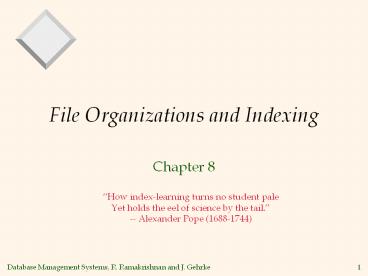File Organizations and Indexing - PowerPoint PPT Presentation
Title:
File Organizations and Indexing
Description:
Composite Search Keys: Search on a combination of fields. ... Data entries. sorted by sal Examples of composite key. indexes using lexicographic order. ... – PowerPoint PPT presentation
Number of Views:49
Avg rating:3.0/5.0
Title: File Organizations and Indexing
1
File Organizations and Indexing
- Chapter 8
How index-learning turns no student pale Yet
holds the eel of science by the tail. --
Alexander Pope (1688-1744)
2
Alternative File Organizations
- Many alternatives exist, each ideal for some
situation , and not so good in others - Heap files Suitable when typical access is a
file scan retrieving all records. - Sorted Files Best if records must be retrieved
in some order, or only a range of records is
needed. - Hashed Files Good for equality selections.
- File is a collection of buckets. Bucket primary
page plus zero or more overflow pages. - Hashing function h h(r) bucket in which
record r belongs. h looks at only some of the
fields of r, called the search fields.
3
Cost Model for Our Analysis
- We ignore CPU costs, for simplicity
- B The number of data pages
- R Number of records per page
- D (Average) time to read or write disk page
- Measuring number of page I/Os ignores gains of
pre-fetching blocks of pages thus, even I/O cost
is only approximated. - Average-case analysis based on several
simplistic assumptions.
- Good enough to show the overall trends!
4
Assumptions in Our Analysis
- Single record insert and delete.
- Heap Files
- Equality selection on key exactly one match.
- Insert always at end of file.
- Sorted Files
- Files compacted after deletions.
- Selections on sort field(s).
- Hashed Files
- No overflow buckets, 80 page occupancy.
5
Cost of Operations
- Several assumptions underlie these (rough)
estimates!
6
Indexes
- An index on a file speeds up selections on the
search key fields for the index. - Any subset of the fields of a relation can be the
search key for an index on the relation. - Search key is not the same as key (minimal set of
fields that uniquely identify a record in a
relation). - An index contains a collection of data entries,
and supports efficient retrieval of all data
entries k with a given key value k.
7
Alternatives for Data Entry k in Index
- Three alternatives
- Data record with key value k
- ltk, rid of data record with search key value kgt
- ltk, list of rids of data records with search key
kgt - Choice of alternative for data entries is
orthogonal to the indexing technique used to
locate data entries with a given key value k. - Examples of indexing techniques B trees,
hash-based structures - Typically, index contains auxiliary information
that directs searches to the desired data entries
8
Index Classification
- Primary vs. secondary If search key contains
primary key, then called primary index. - Unique index Search key contains a candidate
key. - Clustered vs. unclustered If order of data
records is the same as, or close to, order of
data entries, then called clustered index. - Alternative 1 implies clustered, but not
vice-versa. - A file can be clustered on at most one search
key. - Cost of retrieving data records through index
varies greatly based on whether index is
clustered or not!
9
Clustered vs. Unclustered Index
- Suppose that Alternative (2) is used for data
entries, and that the data records are stored in
a Heap file. - To build clustered index, first sort the Heap
file (with some free space on each page for
future inserts). - Overflow pages may be needed for inserts. (Thus,
order of data recs is close to, but not
identical to, the sort order.)
Index entries
UNCLUSTERED
CLUSTERED
direct search for
data entries
Data entries
Data entries
(Index File)
(Data file)
Data Records
Data Records
10
Index Classification (Contd.)
- Dense vs. Sparse If there is at least one data
entry per search key value (in some data
record), then dense. - Alternative 1 always leads to dense index.
- Every sparse index is clustered!
- Sparse indexes are smaller however, some useful
optimizations are based on dense indexes.
Ashby, 25, 3000
22
Basu, 33, 4003
25
Bristow, 30, 2007
30
Ashby
33
Cass, 50, 5004
Cass
Smith
Daniels, 22, 6003
40
Jones, 40, 6003
44
44
Smith, 44, 3000
50
Tracy, 44, 5004
Sparse Index
Dense Index
on
on
Data File
Name
Age
11
Index Classification (Contd.)
- Composite Search Keys Search on a combination of
fields. - Equality query Every field value is equal to a
constant value. E.g. wrt ltsal,agegt index - age20 and sal 75
- Range query Some field value is not a constant.
E.g. - age 20 or age20 and sal gt 10
- Data entries in index sorted by search key to
support range queries. - Lexicographic order, or
- Spatial order.
Examples of composite key indexes using
lexicographic order.
11,80
11
12
12,10
name
age
sal
12,20
12
bob
10
12
13,75
13
cal
80
11
ltage, salgt
ltagegt
joe
12
20
sue
13
75
10,12
10
20
20,12
Data records sorted by name
75,13
75
80,11
80
ltsal, agegt
ltsalgt
Data entries in index sorted by ltsal,agegt
Data entries sorted by ltsalgt






























